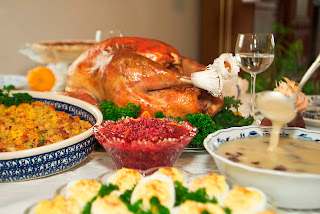INCIRLIK AIR BASE, Turkey -- If you're the appointed to cook the turkey this Thanksgiving and you're stressing to the max because you've never done it before, take comfort in knowing this -- roasting the turkey is the easiest part of the entire traditional feast. Check your commissary for the turkey tailored to your specific needs -- we've got them big and small and everything in between.
We've got disposable roasting pans to cook them in (meaning easy clean-up), turkey roasting bags (meaning faster cooking time) and instant-read thermometers (meaning greater safety). Just choose the products that suit your goal, arm yourself with the following basic guidelines and tips, and you'll be "good to go."
How much do you need? Plan on cooking one-half to three-quarters a pound per person for a regular bone-in turkey, and about one-third a pound per person for a boneless breast or turkey roast. Allow for a bit more if you want plenty of leftovers. Have a houseful of white-meat-only or dark-meat-only lovers? A breast or turkey legs alone might be a better choice than a whole bird. However, if you go this route, you give up the turkey carcass that makes for such good soup once the main feast is over -- decisions, decisions!
How long does it take to thaw? Short answer -- a long time! Place the frozen turkey on a tray in the refrigerator and allow five hours per pound to complete the thawing process. Depending on size, this can take from two to five days. To speed things up a bit, remove the giblet packet and neck from inside the turkey and thaw them separately. Be sure to check both the body cavity and the neck cavity for these; sometimes they are stored in two packets.
If time is short, use the cold water method for thawing, but do so carefully. Spoilage bacteria can multiply rapidly at temperatures above 40 F (4.5 C). With the turkey in its original wrapper, place in a large container and cover completely with cold water. Change the water every 30 minutes and allow an hour per pound for total thawing time.
How to roast? Preheat the oven to 325 F (163 C). Remove giblet packets from inside the turkey, then rinse inside and out with cold water and pat dry with paper towels. Rub the body and neck cavities generously with salt, and insert a medium onion (cut into quarters) and two or three celery sticks with leaves. Sprinkle the skin with salt, then brush all over with melted butter or oil. Place the turkey breast-side-up in a shallow roasting pan and roast on the lowest oven rack until a meat thermometer inserted in the thickest part of the thigh registers 175 to 180 F (79-82 C), and in the breast 160 to 165 F (71-74 C). Refer to your turkey's original wrapper for approximate total roasting times, which can range from two and a half to three hours for a small turkey to four and a half to five hours for a large one.
Remove the turkey from the oven, tent loosely with aluminum foil and let it rest for 15 to 20 minutes before carving.
If you're a tad on the impatient side, or you just need to free the oven for other dishes to compliment the turkey, consider using an oven-roasting bag. You won't produce a picture-perfect turkey with a roasting bag, but looks only matter if you plan to make a big production of carving a beautiful bird at the table. The skin of an oven-bag-cooked turkey will be only lightly brown with some variation in coloring, and it won't be crisp like that of a traditionally roasted bird. The meat will be moist, tender and juicy, though, and the technique can save substantial oven time (from one to one and a half hours, depending on size). Look for the oven bags located near the aluminum foil, and follow the package instructions.
Don't want to roast at all, but prefer to grill or fry instead? You're on your own when it comes to supplying the special equipment for deep-frying turkey, but the commissary's got you covered on the seasonings, injection syringes and the copious quantities of peanut oil you'll need. We even have recipes for turkey grilling or frying on Kay's Kitchen, a special culinary page on the Defense Commissary Agency's official Web site.
To stuff or not to stuff? If your favorite part of the Thanksgiving meal is the stuffing, then by all means choose a reliable recipe and give it a try. Just be aware that food safety experts consider it a breeding ground for pathogens that can make you sick if not done properly. For first-timers, baking a pan of dressing separately is usually easier and definitely safer.
Have a whole unit to feed? Though the commissary can't help you there the Sultan's Inn Dining Facility here can. If you plan on having a unit Thanksgiving function the Sultan's Inn will prepare the food. All food and ingredients must be provided and they can't support Nov. 22 and the 23. Thanksgiving isn't the only holiday that units can use this service. Any other day throughout the year is allowed. The dining facility can make what you need to stuff yourself.
The decision to "stuff yourself," however, is totally up to you! From my viewpoint, it's the one day each year when it's totally acceptable. I'll burn off those extra calories by adding some distance to my daily walk, I tell myself -- but I'll probably need a nap first. After that, I'll see you at the commissary!
Visit Kay's Kitchen at www.commissaries.com/ under the "shopping" link for more details on Thanksgiving turkeys, along with recipes for dressing, fresh cranberry sauce, candied sweet potatoes, pumpkin pie and more.
White House Press Briefing by Dana Perino 11/14/07 VIDEO PODCAST and Thanksgiving Mayflower Pilgrims and UTSA/UT lead national nanoscience consortium
















No comments:
Post a Comment